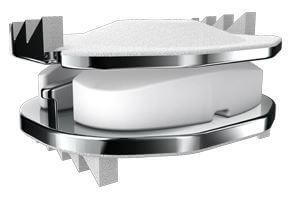The FIRST and ONLY Cervical Disc FDA Approved for Both One & Two Level Indications

SUPERIOR TO FUSION for two-level disc replacement at FIVE YEARS
Mobi-C History
The Mobi-C Cervical Disc is one of the most widely used cervical discs in the world. First implanted in France in November 2004, Mobi-C has been implanted in more than 40,000 spinal levels in 25 countries.
A total of 599 patients were involved in the Mobi-C U.S. clinical trial, which represents the largest concurrent clinical trial ever conducted for cervical disc replacement. Mobi-C received FDA approval in August of 2013, making it the first cervical disc with both one and two-level indications.
Mobi-C How it Works
Mobi-C contains patented mobile bearing technology that allows the polyethylene core to slide and rotate inside the disc for self-adjustment to the cervical spine movements. This means that Mobi-C can react to the normal motion in the cervical spine.
Mobi-C provides bone sparing fixation without chisel cuts into the small vertebral bodies of the cervical spine, making it bone sparing.
Mobi-C Clinical Trial Results at 5-Years
In the one-level study, Mobi-C demonstrated non-inferiority to anterior cervical discectomy and fusion (ACDF) as reflected in the primary composite endpoint. In the two-level study Mobi-C demonstrated SUPERIORITY to ACDF in the primary composite endpoint. Key results from the two-level study include:
Overall trial success was 62.8% for Mobi-C and 34.1% for fusion, which represents statistical superiority (p< 0.0001).
The rate of subsequent surgeries at the operated level for Mobi-C was 3.8% versus 16.2% for fusion.
The percentage of subjects who demonstrated adjacent segment degeneration (determined by x-ray) was:
77.5% of Mobi-C patients compared to 44.9% of ACDF patients at the inferior adjacent level
67.4% of Mobi-C patients compared to 29.2% of ACDF patients at the superior adjacent level
Mean return to work time was 20.9 days shorter for Mobi-C patients compared to fusion patients.
As with any surgery, complications may occur as a result of treatment. Potential complications following treatment with the Mobi-C include:
Pain in the neck, arm, back, shoulder, or head.
The feeling of pins and needles in the arms.
Difficulty swallowing.
Please visit www.cervicaldisc.com/aboutyourneck for a complete list of potential risks and benefits of Mobi-C surgery. Visit www.cervicaldisc.com/clinical-results for indications and detailed clinical results.
Would you like to find out more about this amazing technology and see how it works? You can also view patient testimonials about how the Mobi-C has helped restore their mobility. Click below to learn more.